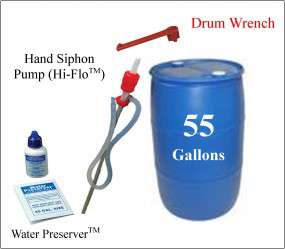 Short-Term Water Storage is any water storage that is designed to provide drinking water for 90 days or less (3 months). That is my definition and what I recommend working toward, if you haven't achieved that already. Whether you are a doomsday prepper, or just someone who feels it's a good idea to have extras on hand for an emergency, a three-month supply is an excellent foundation to build. Let's get specific now:
Short-Term Water Storage is any water storage that is designed to provide drinking water for 90 days or less (3 months). That is my definition and what I recommend working toward, if you haven't achieved that already. Whether you are a doomsday prepper, or just someone who feels it's a good idea to have extras on hand for an emergency, a three-month supply is an excellent foundation to build. Let's get specific now:
- Why 90-Days?
- How do I store it?
- Where should I store it?
Why 90-Days?
Ninety-Days is a relatively short amount of time. I have researched and continue to research data that is compiled by experts such as scientists, engineers, geologists, etc.. Much of their data is available if you know where to look, know what you are looking for, are able to get past the dry gobs of information, and most importantly, if you have the time to do this. Having said that, my recommendation for a ninety-day minimum of storage considers the earliest that water could be made available to the masses, but anticipates that you could at least “be on your own” for that amount of time. I also believe that when a major earthquake, or an event of significant magnitude strikes, three months time is a “transition time” for people to adapt to new situations.
There is much debate regarding this point, particularly regarding storage containers. I recommend using brand-new and unused containers, such as 55 gallon drums, Aquatanks, and other containers which are designed to be used for long-term storage of drinking water for humans. HDPE (high-density polyethylene) is a popular option that many people use for storage containers. Many prepper minded people do whatever they can to save a buck in their preps, but in choosing a safe container, I don't recommend being stingy.
One of the biggest myths out there is that using “food-grade” or “certified-reconditioned” drums are perfectly safe or “as-good-as” virgin containers. If we're talking about plastics, that is completely false for at least two reasons: (1) all plastics will absorb and retain a percentage of whatever chemicals or liquids which are stored inside, over the life of the container, and (2) these chemicals or liquids will leach back into the drinking water that is stored inside. Even when companies steam-wash the drums or do chemical washing of the drums, they cannot remove what has been absorbed into the plastic. Remember, these drums are used within the food industry to store concentrated liquids and formulas. Therefore, the plastic absorbs percentages of concentrates, which is why I recommend spending a little more money to buy an unused, brand-new container for your drinking water. If you absolutely have to use a re-conditioned drum, at least use a drum liner to ensure safety.
You'll also want to look at several options available to treat the water for storage. Here's another area of controversy. I recommend using Water Preserver Concentrate for your water storage and rotate your water out every 6-12 months. There are other products out there that are good products, but I recommend only the ones that have some kind of verifiable lab testing. Although there are good products out there which sound solid in theory, too many knock-offs exist which have compromised my trust for the few that actually work but have no verifiable data to support. The main point here is to treat your water so as to secure it from pathogenic microbes, contamination, and compromise.
Where should I store it?
Once you've decided on your water storage containers to house your Short-Term CCP, you'll need to choose a couple of different locations to store the water for access when it's needed. Always be sure to keep your water storage in an area with these principles in mind:
- Cool & Dark: Out of direct sunlight & away from exposure to extreme temperatures
- Dry: Away from areas of potential flooding, extreme humidity, and critters
- Accessible: Place water storage in various locations where easily & readily accessible and safeguarded
Keep your water storage in temperature ranges of 60-70 degrees Fahrenheit. This will maximize storage life and quality, along with the other factors mentioned previously.
It is also a good idea to be strategic about placing your water storage. For example, avoid placing barrels in open areas where tampering can easily occur or under trees where bird-droppings might pose a contamination risk. Placing your water storage in one location might complicate things if your access to that location is restricted, so spread it out to at least two or three locations. They can all be on the same site, just different locations.
Be sure to review your CCP regularly with those whose lives may depend on it within your family, friends, or network of only trusted and reliable associates. They should know how, where and when to access it when necessary.
Part 1/5 Part 2/5 Part 3a/5 Part 3b/5 Part 4/5 Part 5/5
-The Berkey Guy








No comments yet.